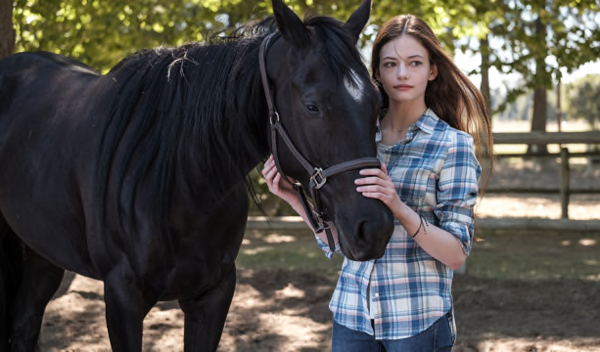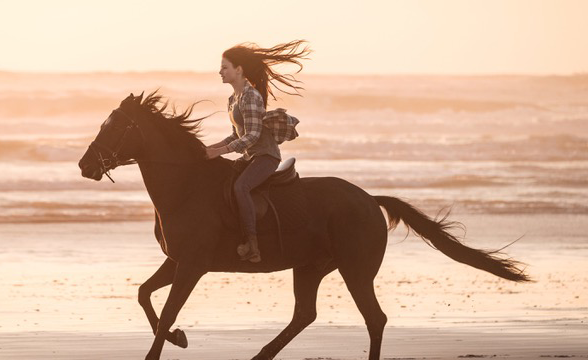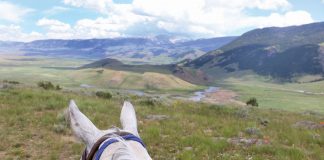
When Anna Sewell wrote the novel Black Beauty in 1877, her goal was to call attention to the desperate plight of London carriage horses. Nearly 150 years later, Black Beauty is still an inspiration to those who care about horses—like Ashley Avis, the writer and director of the new Disney+ film, Black Beauty.
True to the novel, the film version of Beauty tells her own story (voiced by Kate Winslet). While Sewell wanted readers to understand the plight of carriage horses, Avis wants viewers to grasp the hardships suffered by America’s Mustangs. While researching Mustang advocacy groups, such as the American Wild Horse Campaign and Lifesavers World Horse Rescue, Avis came to under how and why wild horse are rounded up on public lands.
“The issue needs to be better illuminated, and I thought that our contemporaneous version could make a difference for wild horses,” she says.
The film includes an actual helicopter roundup of Mustangs in Nevada. Avis and her husband, Edward Winters, who is the executive producer on Black Beauty, witnessed a roundup. She says they were shaken and ended up adopting two of the Mustangs from the roundup. They were also inspired to launch their own nonprofit, The Wild Beauty Foundation, which is dedicated to the protection of wild and domestic horses in North America through film, education, rescue and adoption.

Equine Actors
While the roundup depicted in the film was real, the rest of the horse action was carefully scripted. More than 20 horses were cast to play Beauty at various stages of her life, with four off-the-track Thoroughbreds portraying Beauty at her main age in the film.
Each horse was cast for specific behaviors, which the trainers focused on developing. One mare, Jenny, had a quiet, whimsical nature and is most often seen bonding with the main character of Jo Green in the film.
“Jenny does all the work with the actor,” says liberty horse trainer Cody Rawson-Harris, who worked on the film. “She is required to do short calls, lay downs, head nods, looks left and right, pull faces, prick her ears and a bit of a rear.”
Spirit, the other horse heavily featured in the film, was often used for scenes with long-distance running.
“Spirit, who is my personal favorite, plays Black Beauty when she’s wild,” says Avis. “As her name suggests, she’s very spirited.”
Spirit’s temperament created a challenge when attempting to film one scene where Beauty gallops through a canola field filled with vibrant yellow flowers.
“Spirit galloped so fast, the drone [that was filming] literally couldn’t keep up with her,” says Avis. “It took us a number of takes to get the shot because Spirit was racing at a speed nobody expected.”
Casting horses that can perform as expected while also having a similar look can be a challenge. Most of the horses playing Black Beauty were not actually black and had to be painted to look the part. Horse-safe henna dye was used to replicate Beauty’s signature black color, and a white star was hand painted onto each horse’s forehead.
The makers of Black Beauty are hoping to send an important message with the film that ultimately leads to a better understanding of the plight of wild horses.
”Our movie is not didactic, but there is a message of hope that transcends Beauty’s hardships and her journey,” says producer Jeremy Bolt. “Our film is not a documentary—it’s a piece of emotional entertainment—but there’s no harm in shining a light on a very, very valid and important cause.”






All too often, wild horses and their behavioral ecology are not correctly represented in Hollywood films. And that’s because producers and most writers are too far removed from the wilderness where they live, nor are they able to get close enough to grasp the nature of these enlightened beings.
Here are a couple of articles that I have written after living among wild horses in the Soda Mountain wilderness of the Cascade-Siskiyou mountains on the Oregon-California border for the past 7-years at my ranch; Wild Horse Ranch:
1) https://www.horsetalk.co.nz/2018/07/04/wild-horses-death-grief-insight/
2) https://grazelife.com/blog/wild-horse-fire-brigade-lessons-in-rebalancing-north-american-ecosystems-by-rewilding-equids/
And an award-winning natural history documentary about wild horses titled: Fuel, Fire and Wild Horses: Vimeo: https://vimeo.com/327282987
Cheers! William E. Simpson II – Naturalist / Rancher
Wild Horse Ranch
Bona-fides at: http://www.WHFB.us
Loved this movie a lot. Says a lot about how the roundups affect the mustangs when torn from their families. It was especially disturbing to see other mustangs being loaded into the semi trailer, it makes you think that the BLM is sending mustangs to slaughter. Especially when they are taken to holding facilities where the public is not allowed. What goes on there that they don’t want you to know about? Are they being beneficial to the mustangs, or are they carrying out the horrible spayings on the mares, and if they die, who cares? Just dig a bigger hole. I don’t trust the BLM in any way, and certainly don’t believe that what they are doing is in the best interests of the mustangs.
This is literally a generic horse movie (ALL cliques included!) with the title “Black Beauty” slapped onto it.
It’s a disgrace to the book (And it’s numerous actually faithful movie adaptions!), misleading (Lol seriously, why is it called “Black Beauty” what it is neither an adaption of the book nor a remake of any of the previous movie adaptions?) and hilariously inaccurate (It’s literally “Super amazing teenage girl meets super amazing horse that only SHE can tame and understand! Realistic horsemanship need not apply!) in so many ways that it’s not even worth watching, let alone re-watching.
Disney must truly be desperate for Disney+ content if they actually went through the bother of acquiring the distribution rights to this “movie”.
I own a wild-caught Mustang. She came from the Wheeler Pass, NV Horse Management Area (HMA). This is typical Disney. Making movies to pull on people’s heartstrings, not to show truth. What this story fails to explain is that these wild horses multiply like rabbits. I did a lot a research trying to find out where our “Annie” came from, as I wondered if given the opportunity would she rather be out in the wild with the herd. That was until I saw pictures of an emergency roundup in 2015, then again in 2017, and I met the current lady responsible for creating a management plan for this HMA. The local people were calling the BLM nonstop back in 2015, because those horses had nothing to eat. They were starving. They were pulling down small brush trees, stomping them to get to the inside bark. I sat at my computer in tears looking at pics of starving horses and foals. You could count their ribs. During that first emergency roundup in 2015, the BLM had to put down 128 horses, because they were too far gone from starvation. At that point I realized I gave Annie a better home than she would have ever had in the wild. As with many things, we romanticize what it’s really like, yet have no real idea. You can’t try to move these horses to another area, because they find their way back. The BLM tries everything possible to watch these herds, but the numbers keep mounting for those they have tried saving from a cruel death — starving to death, either by not enough food, or not enough water. They have created water stations for the herds who don’t have close access to water. So, go and enjoy this fantasy movie, which Disney is famous for, but just enjoy it to enjoy it, because there is no truth — because there is no easy answer how to control the population of these wild horses. And it doesn’t help when people drop their horses off in the middle of nowhere, because they can’t care for them anymore. Yes, horses have been rounded up with SHOES ON. If Disney wanted to do a movie, maybe they should have done one about over breeding domesticated horses, because there are many of them who go to meat auctions, just like some of the Mustangs do. There is more to this story than they are telling. And let’s not forget, they didn’t even use a Mustang for the real horse character. That tells you what their agenda is, because there are some fabulous Mustang trainers out there who really are trying to help the plight of these wild horses. Disney is just doing it for the box office $$$$$$ the movies bring in.